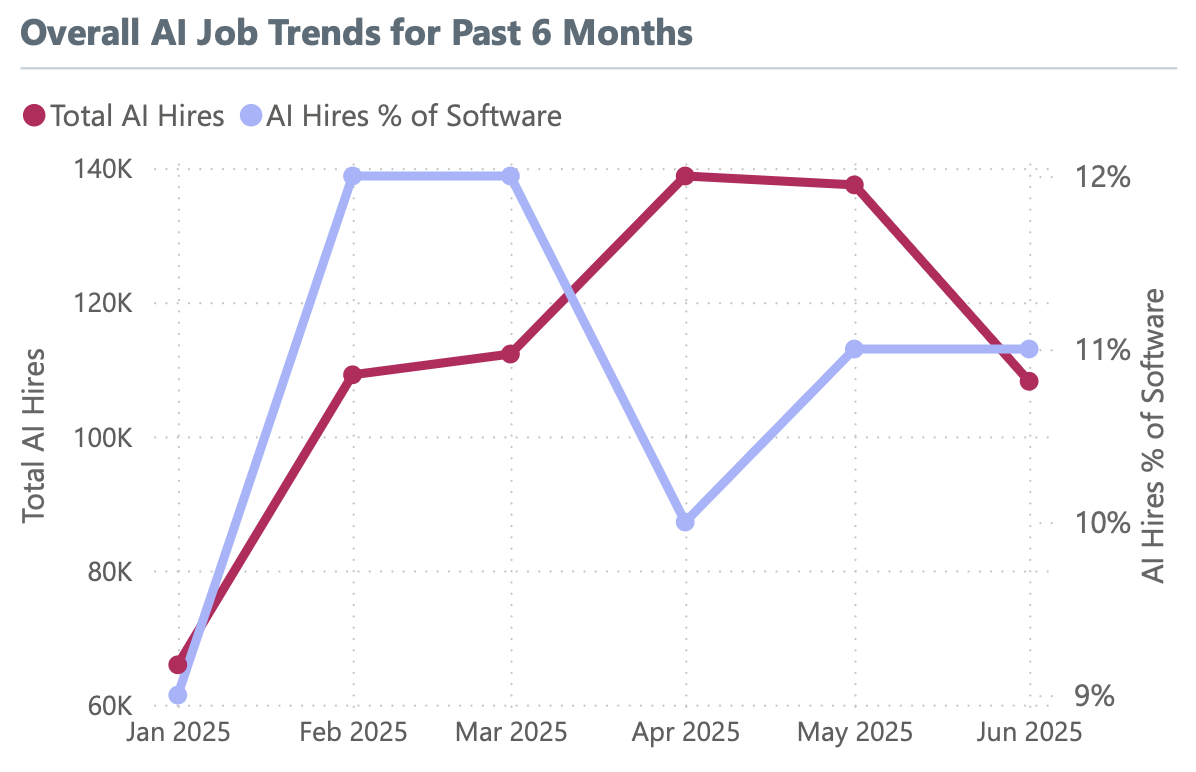What Aura’s AI Jobs Report Reveals About the Future of Work
The AI job market is shifting rapidly and not always in the direction you'd expect. Fueled by a mix of early-year hiring surges, geographic expansion, and evolving industry needs, AI roles are no longer confined to coastal tech hubs or limited to data scientists and ML engineers.
Major players, such as Amazon, are acknowledging the widespread impact of AI on the workforce. In a recent internal memo, CEO Andy Jassy confirmed that the company expects a reduction in total corporate headcount as AI-driven efficiencies take hold, while also ramping up hiring in entirely new types of roles.
So, what’s actually happening in the world of AI jobs, and where is it all headed next? Here’s a deep dive into the latest data from Aura’s July 2025 AI Jobs Report, with curated dashboards and visualizations to help make sense of the momentum and the recalibration.
Want to benchmark your AI hiring strategy against the latest trends? Request a free AI talent report and demo from Aura today.
AI Hiring in 2025: Early Surge Followed by Strategic Slowdown

The first half of 2025 kicked off with a hiring frenzy. Between January and April, AI-related job postings more than doubled—from 66,000 to nearly 139,000. That spike came on the back of a corporate scramble to scale generative AI capabilities, integrate large language models, and rebuild outdated data infrastructure.
But starting in May, the momentum began to ease. By June, AI hiring had cooled slightly. This can’t be called a collapse, just a recalibration. As many companies digested the cost and complexity of AI integration, they may have slowed hiring to focus on deployment, training, and alignment across teams.
Despite the moderation, AI jobs still consistently represented 10–12% of all software-related roles: a sign that AI is becoming embedded across the tech industry, not just a separate function.
Where AI Jobs Are Growing: From Tech Hubs to Surprising States

As expected, California continues to lead the way, posting a solid 10% increase in AI hiring this year. But what’s surprising is where else AI jobs are growing: Alabama, for instance, saw one of the highest percentage increases, even though it came from a smaller base.
New York is another standout, driven by the growing role of AI in finance and healthcare. Meanwhile, Alaska and Arizona posted modest declines, possibly due to project completions or temporary hiring freezes.
This indicates that AI job creation is no longer limited to the coasts but is expanding inland, emerging in mid-sized cities, and forming new industry clusters.
Industries Leading the AI Hiring Wave in 2025

Based on the latest July 2025 data, the five industries with the most AI job postings are:
-
Information Technology and Services
-
Computer Software
-
Internet
-
Staffing and Recruiting
- Human Resources
These sectors currently top the list in terms of AI hiring volume.
But not all sectors are booming. The data also reveals where AI hiring has stalled or reversed. For example, traditional retail and wholesale saw a dip, possibly a sign that AI investment in this space is plateauing.

Most In-Demand AI Skills: From LLMs to MLOps
Across the board, roles requiring skills in machine learning engineering, LLM fine-tuning, AI ethics, and MLOps are commanding the most attention and compensation. Companies are also hiring for increasingly niche positions—such as AI prompt engineers, model evaluators, and trust and safety specialists—indicating how quickly the field is diversifying.
That demand is driving serious competition: Meta, for example, has been offering multimillion-dollar pay packages to lure top AI talent into its new superintelligence lab. While not everyone is receiving a $100 million deal (despite rumors), compensation offers in the $10–20 million range are reportedly being made and sometimes even rejected. This signals just how hot the market is for elite AI researchers.
It all reflects a broader shift toward skills-based hiring, which aligns with Aura’s latest workforce trends showing that companies are prioritizing job capabilities over credentials. AI teams aren’t just growing, they’re maturing.
The Future of AI Jobs: What Comes Next
If the first half of 2025 taught us anything, it’s that the AI jobs market is no longer speculative hype. It’s real, it's structural, and it's here to stay. Companies are integrating AI not just as a standalone function but as an embedded capability across software, product, ops, and R&D teams.
Still, we expect continued fluctuations. Economic headwinds, budget reviews, and shifting regulatory frameworks will all impact hiring decisions. But long term? AI is becoming an integral part of how industries operate, from decision-making to value creation.
What Employers and Investors Can Learn from the Data
If you're hiring, it’s time to think beyond just finding “AI people.” You need to define what AI capabilities your team actually needs, assess where you’re falling behind competitors, and tailor your talent strategy accordingly.
If you're investing, Aura’s real-time workforce data can help you evaluate whether a company’s AI team is hype or truly differentiated. Are they overstaffed in vanity roles? Under-invested in production engineers? That’s the kind of insight our AI-powered platform delivers.
Better Understand AI Transformation and Opportunity
This moment isn’t just about job creation, but about transformation. The companies that win in the AI economy will be those that pair technical hires with strategic clarity. They’ll utilize workforce intelligence, such as Aura's, not just to react to trends, but to drive them.
Want to see how your AI hiring compares to your peers? Request a free AI workforce benchmarking demo with Aura today.


